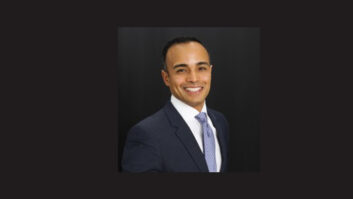Last year the Clear Channel Radio cluster in Pueblo, Colo., with the help of the satellite division in Denver, was able to do live remotes successfully from a major Southern Colorado event directly into its studios.
The purpose was to explore satellite use for remotes. For this reason, the link had to perform exactly as a microwave link would during a customer remote. The remotes were part of an exploration of satellite technology.
The two-week event gave Pueblo stations KCSJ(AM), KGHF(AM), KPHT(FM) and KDZA(FM) a good opportunity to test the transmit and receive equipment needed for live satellite broadcasting.
The satellite trailer was centrally located, providing easy access to our four station locations.
The equipment used for our remote link is shown in the accompanying box.
SpecsFair Grounds
Dish size: .96 m
Transmitter: 25 Watts
ComStream DAC 7000
CDM 600L Modem
Behringer Mixer UB802 (for line input to DAC)
Studio
Dish size: 1.8 m Fly Away
Receiver: Comstream 202
Satellite used: AMC 4 (Ku Band)
Studio receive signal quality: 14.2 EvNo
The DAC required a line input, so the Behringer mixer was used. (Note: The line output from a Marti or other similar receiver could have also been used.) Both a wired and wireless mic were plugged into the mixer.
The UHF wireless mics did not perform well initially due to obstacles at that location. However, when the receiver was elevated above the satellite trailer, the two AM sites were able to use them. The FM stations used the hard wired mic located in the satellite trailer. Studio functions (Prophet/ACU Switching) were controlled using wireless laptop computers, which has been standard procedure at remotes for Pueblo.
There is a delay of approximately 650–700 ms. So the key is not to add any additional delays to the signal you are receiving at the studio. For this reason, the audio output from the ComStream 202 receiver went directly into the ACU switch, which was activated using our wireless laptops.
If your downlink is to another location other than the studio and you’re having to ISDN back to your studio, additional audio delay time will be encountered.
The ‘real thing’
We have many outlying areas where we could sell additional live remotes using satellite technology where STL links and wireless are weak and spotty with dropouts. In many cases the customer does not want his phone line used and frowns upon use of a cell phone for remotes. He wants the real thing.
This event was the perfect opportunity to test the waters, with a direct satellite link to our main studios.
The satellite dish for radio remotes would be smaller in size and would only require 4–8 watts of transmit power. It easily could be attached to any luggage carrier of a remote vehicle. A dedicated receive dish at the studio is desirable.
Total costs for remote equipment and studio costs would be in the neighborhood of $28,000. If you shop around, you can do it for less.
Satellite for radio remotes, although not new to radio, has a lot of promise for customer remotes. Most stations don’t want to deal with the initial expense and satellite time costs. Satellite time can be negotiated and there are package plans.
The other issue is the audio delay (650-700 ms), although some wireless phone equipment using cell technology has similar delays in many cases. To eliminate the echo, the headset can be plugged into the mixer so you only hear yourself. If you have wireless IFB gear, you can silence the live portion of the broadcast. Even the old Comrex Buddy system would work if you happen to have one lying around.
When you are using wireless laptops to control studio functions as we do in Pueblo, the air talent can see where he is during the remote and activate the next event when ready, making the audio delay almost transparent.
Conclusions
The satellite equipment was easy to use. Setup was easier than using conventional RPU transmit equipment. There is no hurry-up mask, tripods or bent antennas to deal with.
With the auto align satellite dish, air talent simply push the align button when the satellite is found and the button turns green. Push the button again to park the satellite in the home position.
Several live spots were done with our AM and FM stations during the 10-day period without any technical problems. The audio quality was excellent for the AM and FM stations. The audio delay was not an issue.
If your company is working on a disaster plan, a portable sat that can be quickly mounted on a vehicle with a fixed dish at the transmitter site may be something to consider.












